Burundi |
|
|
|
| Übersicht – Contents: | |
Burundi |
|
|
|
| Übersicht – Contents: | |
Flagge – Flag: |
|
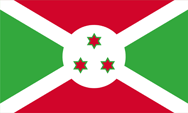 |
Nationalflagge – national flag, Seitenverhältnis – ratio = 3:5, Quelle/Source: Corel Draw 4, Flags of the World |
historische Flaggen – historical Flags: |
|||||||||
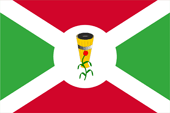 |
01.07.1962–28.11.1966, Nationalflagge – national flag, Seitenverhältnis – ratio = 2:3, Quelle/Source nach/by: Die Welt der Flaggen
|
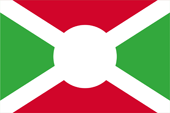
28.11.1966–28.07.1967, |
Nationalflagge – national flag, Variante 1, Seitenverhältnis – ratio = 2:3, Quelle/Source nach/by: Flaggen und Wappen der Welt
|
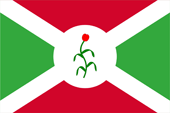
28.11.1966–28.07.1967, |
Nationalflagge – national flag, Variante 2, Seitenverhältnis – ratio = 2:3, Quelle/Source nach/by: Flaggen und Wappen der Welt
|
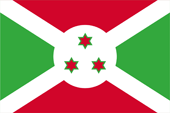
28.07.1967–27.09.1982, |
Nationalflagge – national flag, Seitenverhältnis – ratio = 2:3, Quelle/Source nach/by: Flaggen und Wappen der Welt | ||
Bedeutung/Ursprung der Flagge – Meaning/Origin of the Flag: |
|
| Das Königreich Burundi wurde am 01.07.1962 unabhängig. Die in diesem Zusammenhang eingeführte Flagge wird durch ein weißes diagonales Kreuz in vier Viertel geteilt, links und rechts je ein grünes, oben und unten je ein rotes. In der Mitte trug die Flagge eine weiße Scheibe mit einer Trommel (Symbol der Tutsi-Monarchie) und einer Hirsepflanze darauf. Grün steht für die Hoffnung, Rot für das im Unabhängigkeitskampf vergossene Blut, und Weiß für den Frieden. Die Monarchie wurde am 28.11.1966 gestürzt, und die Republik ausgerufen. Nach Zwischenlösungen wurde die Flagge am 28.07.1967 in ihre heutige Form gebracht. Die Trommel und die Hirsepflanze auf der Flagge von 1962 wurden durch drei rote, grün umrandete, sechszackige Sterne ersetzt. Die drei Sterne stehen für das Motto des Staates "Unité, Travail, Progress" => "Einigkeit, Arbeit, Fortschritt", bzw. für die drei Volksgruppen im Lande, die Tutsi, Hutu und Twa. Im Jahre 1982 wurden die Seitenverhältnisse der Flagge von 2:3 auf 3:5 abgeändert. Als Farben für die Flaggen werden heute angegeben: Rot = pt 186, Grün = pt 361 und Weiß. | The Kingdom of Burundi
became independent on the 1st of July in 1962. The in this context introduced flag is
divided by a white diagonal cross into four fourth, to the left and to the right ever one
green, above and below ever one red. The middle of the flag carryed a white disk with a
drum (symbol for the Tutsi monarchy) and a millet plant thereupon. Green stands for the
hope, red for the in the fight for independence shed blood, and white for the peace. The
monarchy was unseated on the 28th of November in 1966, and was proclaimed the republic.
After interim solutions the flag was changed into her today's form on 28th of July in
1967. The drum and the millet plant on the flag from 1962 got substituted by three red,
green bordered, six-jagged stars. The three stars stand for the motto of the state
"Unité, Travail, Progress" => "unity, work, progress",
respectively for the three ethnic groups in the land, the Tutsi, Hutu and Twa.
In 1982 the ratio of the flag sides was changed from 2:3 to 3:5. The colors
given for the flags today are: red = pt 186, green = pt 361 and white. |
| Quelle/Source: Flaggen und Wappen der Welt, Flags of the World | |
Wappen – Coat of Arms: |
|||
 |
seit/since 1966, Wappen von Burundi – coat of arms of Burundi, Quelle/Source: Corel Draw 4 |
||
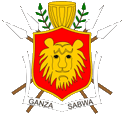 |
1962–1966, Wappen von Burundi – coat of arms of Burundi, Quelle/Source nach/by: Flags of the World | ||
Bedeutung/Ursprung des Wappens – Meaning/Origin of the Coat of Arms: |
|
| Das erste Wappen von 1962 zeigte einen roten Schild mit einem goldenen Löwenkopf, dahinter vier gekreuzte Speere, oberhalb des Schildes die Tutsi-Trommel, und darunter in einem Schriftband das Staatsmotto: "Ganza Sabwa" => "Herrschen Regieren". Nach Ausrufung der Republik wurde einer der Speere und die Trommel entfernt, und das Staatsmotto wurde abgeändert. Die drei Speere beziehen sich auf sie drei Sterne in der Flagge. | The initial coat of
arms from 1962 showed a red shield with a golden lion head, behind it four crossed spears,
above the shield the Tutsi drum, and underneath in a ribbon the motto of the state:
"Ganza Sabwa" => "govern rule". After the proclamation of the
republic one of the spears and the drum got deleted , and the motto of the state was
changed. The three spears refer to the three stars in the flag. |
| Quelle/Source: Flaggen und Wappen der Welt | |
| Landkarten – Maps: |
Lage – Position: |
Landkarte des Landes – Map of the Country: |
Zahlen und Fakten – Numbers and Facts: |
|
|
|
|
|
|
|
|
|
|
|
|
|
|
|
|
|
|
|
|
|
Geschichte: |
| 16. Jhd. bis
19. Jhd. · Tutsi-Königreiche August 1884 · Errichtung des deutschen Protektorats 01.07.1890 · formeller Anschluss an Deutsch-Ostafrika 1896 · reguläre deutsche Inbesitznahme, Errichtung der Kololnialverwaltung 1914–1918 · Erster Weltkrieg (1916 · belgische und britische Truppen erobern Deutsch-Ostafrika, Widerstand der deutschen Schutztruppe bis zum 14.11.1918) 1919 · Ruanda und Urundi kommen unter belgische Kontrolle 1920 · Versailler Diktat, das Deutsche Reich verliert alle seine Kolonien, Deutsch-Ostafrika wird zwischen Belgien, Großbritannien und Portugal aufgeteilt – das heutige Burundi wird zusammen mit den heutigen Ruanda als "Ruanda-Urundi" ein Mandatsgebiet des Völkerbundes unter belgischem Mandat 20.07.1922 · Errichtung der belgischen Mandatsverwaltung 1946 · das Mandatsgebiet des Völkerbundes wird UNO-Treuhandgebiet unter belgischer Verwaltung 21.12.1961 · Belgien gewährt Autonomie 01.07.1962 · Unabhängigkeit 28.11.1966 · Sturz der Tutsi-Monarchie 1976 · Tutsi-Putsch 1987 · Tutsi-Putsch Juni 1993 · Wahlen, Sieg der Hutu, Wahl eines Hutu-Präsidenten Oktober 1993 · Ermordung des Hutu-Präsidenten 1993–1994 · Bürgerkrieg 1994 · Wahl eines Hutu-Präsidenten 1996 · Tutsi-Putsch 2000 · Friedensvertrag von Arusha |
History: |
| 16th cent. to
19th cent. · Tutsi Kingdoms August 1884 · establish of the German protektorate 1st of July 1890 · formal annexation to German East Africa 1896 · regular German appropriation, establish of the colonial gouvernment 1914–1918 · First World War (1916 · Belgian and British troops conquer German East Africa, resistance of the German colonial forces until 14th of November 1918) 1919 · Rwanda and Urundi come under Belgian control 1920 · Treaty of Versailles, the German Empire loses all its colonies, German East Africa is divided between Belgium, Great Britain and Portugal – today's Burundi, together with the today's Rwanda becomes as "Rwanda-Urundi" a mandate of the League of Nations under Belgian mandate 20th of July 1922 · establishment of the Belgian mandate administration 1946 · the Mandate of the League of Nations becomes a UN trust territory under Belgian administration 21st of December 1961 · Belgium grants autonomy 1st of July in 1962 · independence 28th of November in 1966 · fall of the Tutsi monarchy 1976 · Tutsi coup 1987 · Tutsi coup June 1993 · elections, victory of the Hutu, election of a Hutu president October 1993 · assassination of the Hutu president 1993–1994 · civil war 1994 · election of a Hutu president 1996 · Tutsi coup 2000 · peace treaty of Arusha |
| Quelle/Source: Wikipedia (D), World Statesmen |
Ursprung des Landesnamens – Origin of the Country's Name: |
|
| Der Name "Burundi" (eigentlich Uburundi) bedeutet in der Kirundi-Sprache "Vaterland". In der Kolonialzeit wurde "Urundi" verwendet. | The name "Burundi" (actually Uburundi) means in the Kirundi language "fatherland". In the colonial times was "Urundi" in use. |
| Quelle/Source: Handbuch der geographischen Namen, Volker Preuss | |